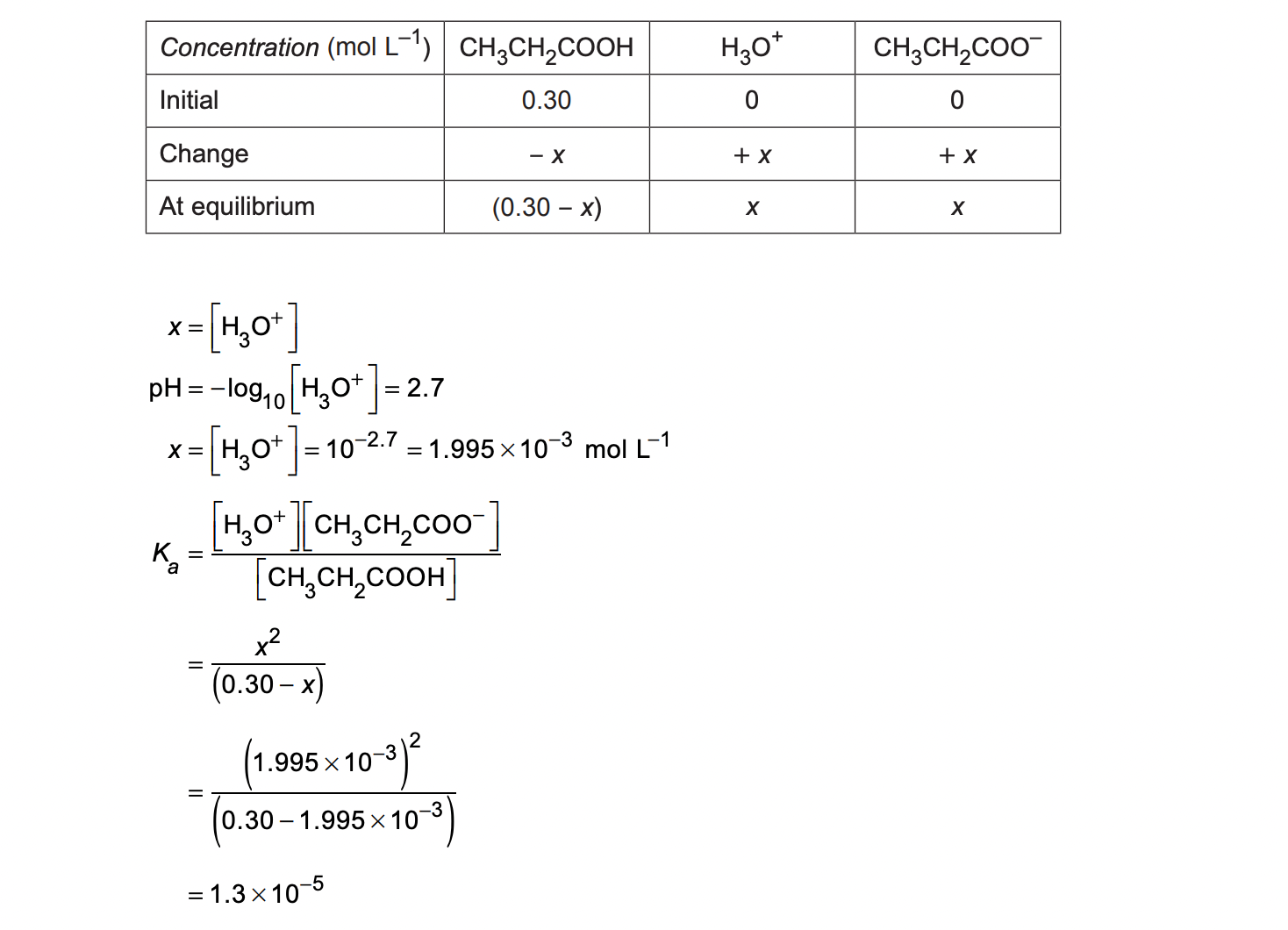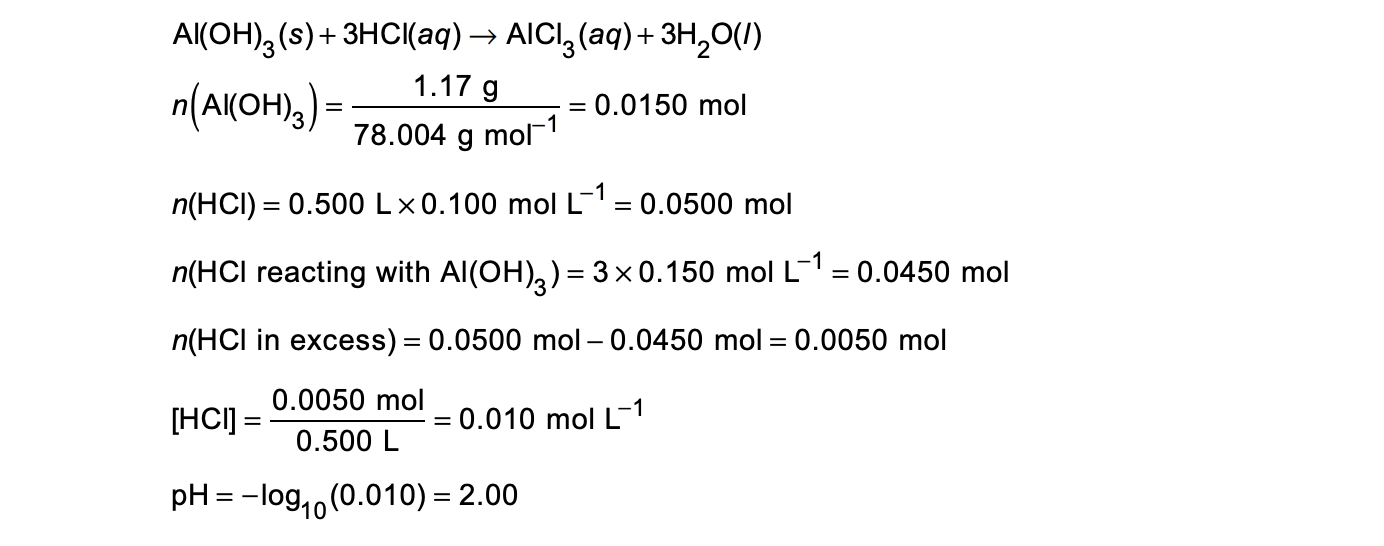- Question 1
- Question 2
- Question 3
- Question 4
- Question 5
- Question 6
- Question 7
- Question 8
- Question 9
- Question 10
- Answer Key
- Additional Helpful Resources
Question 1
The pKa of trichloroacetic acid is 0.70 and the pKa of acetic acid is 4.8. Which of the following identifies the acid with the higher pH and explain why? (1 mark)
A. Acetic acid as it is less likely to lose a hydrogen ion
B. Acetic acid as it is more likely to lose a hydrogen ion
C. Trichloroacetic acid as it is less likely to lose a hydrogen ion
D. Trichloroacetic acid as it is more likely to lose a hydrogen ion.
Question 2
Chlorous acid (HClO2) has a pKa of 1.96. Nitrous acid (HNO2) has a pKa of 3.39. Which of the following solutions has the highest pH? (1 mark)
A. 0.1 M HNO2
B. 0.1 M HClO2
C. 0.1 M NaNO2
D. 0.1 M NaClO2
Question 3
A neutralisation reaction takes place between 50 mL of 0.1 mol/L sulfuric acid and 75 mL of 0.15 mol/L sodium hydroxide. What is the pH of the solution after the reaction has occurred? (1 mark)
A. pH 2
B. pH 7
C. pH 12
D. pH 13
Question 4
(a) The pH of a 0.30 M aqueous propanoic acid solution was measured to be 2.7. The dissociation of propanoic acid is represented below.
CH3CH2COOH(aq) + H2O(l) ⇌ CH3CH2COO−(aq) + H3O+(aq)
Calculate the Ka of the solution. (3 marks)
(b) Explain how the pH of the propanoic acid solution would change if it was diluted. (3 marks)
Question 5
Explain why a mixture of acetic acid (1 M) and sodium acetate (1 M) can act as a buffer while a mixture of hydrochloric acid (1 M) and sodium chloride (1 M) cannot. (3 marks)
Question 6
The concentration of hydrochloric acid in a solution was determined by an acid-base titration using a standard solution of sodium carbonate.
(a) Explain why sodium carbonate is a suitable compound for the preparation of a standard solution. (2 marks)
(b) A 25.00 mL sample of 0.1050 mol L–1 sodium carbonate solution was added to a conical flask and three drops of methyl orange indicator were added. The mixture was titrated with the hydrochloric acid and the following readings were recorded.

Using the data from the table, calculate the concentration of the hydrochloric acid. (3 marks)
(c) Explain the effect on the calculated concentration of hydrochloric phenolphthalein is used as the indicator instead of methyl orange. (2 marks)
Get direct advice from our HSC Chemistry Tutor Specialists who can help you with Acid-base Reaction Chemistry preparation and general exam strategy! 👇
Question 7
A student adds 1.17 g of Al(OH)3(s) to 0.500 L of 0.100 mol/L HCl(aq). Calculate the pH of the resulting solution. Assume that the volume of the resulting solution is 0.500 L. (4 marks)
Question 8
(a) Justify the continued use of the Arrhenius definition of acids and bases, despite 3 the development of the more sophisticated Brönsted–Lowry definition. (3 marks)
(b) Why does the neutralisation of any strong acid in an aqueous solution by any strong base always result in a heat of reaction of approximately –57 kJ mol/L? (2 marks)
Question 9
A student completely neutralised a 50 mL aliquot of 0.1 mol L-1 NaOH using a 50 mL aliquot of 0.1 mol L-1 HCl. They were then surprised to discover that 50 mL of 0.1 mol L-1 propanoic acid also neutralised the same volume and concentration of NaOH.
a) Explain why the same volume of both acids was required to neutralise the NaOH solution, even though one was strong and one was weak. (3 marks)
b) The student then compared the pH of the NaOH solution neutralised by the HCl (Reaction X) with the pH of the NaOH solution neutralised by the propanoic acid (Reaction Y) and found that they were different. Using relevant chemical equation(s), account for the difference in pH of the two solutions and identify which had the higher pH. (4 marks)
Question 10
A primary standard was prepared by dissolving 16.45 g of sodium carbonate in 2.00 L of distilled water. This solution was then used to standardise a solution of hydrochloric acid. An average titre volume of 12.93 mL of the sodium carbonate solution was required to neutralise 20.00 mL of the hydrochloric acid.
The hydrochloric acid was then used to calculate the concentration of sodium hydroxide in a household cleaning solution. A 10.00 mL sample of the cleaning solution was diluted by adding distilled water up to a volume of 250.0 mL in a volumetric flask. Five 20.00 mL aliquots of the diluted cleaner were titrated against the hydrochloric acid.

Calculate the concentration of the sodium hydroxide in the original cleaning solution. (8 marks)
What Our Students & Parents Say
Real reviews from students and parents across all our tutoring programs — collected from Google, Trustpilot, and more.
Answer Key
Question 1. A
Question 2. C
Question 3. C
Question 4. (a)

Question 4. (b)
Propanoic acid is a weak acid and thus will only partially ionise in solution.
CH3CH2COOH(aq) + H2O(l) ⇌ CH3CH2COO−(aq) + H3O+(aq)
When the acid is diluted, the concentration of all species (including the hydronium ion) decreases. However, the effect of the decreasing concentrations of dissolved species causes the equilibrium to shift to the right (according to Le Chatelier). While there is an increase in ionisation, this is not sufficient to counter the decrease in hydronium ion concentration caused by the addition of water (dilution effect). The net effect is the hydronium ion concentration decreases and the pH increases.
Question 5.
A mixture of acetic acid and sodium acetate is a mixture of a weak acid and the salt of its conjugate base. As the conjugate base of a weak acid is a moderately strong base, CH3COO– will have a tendency to react with H+ ions in solution according to the following equation:
CH3COOH(aq) ⇌ CH3COO– (aq) + H+(aq)
Any addition of H+ ions will drive the equilibrium to the left absorbing H+ ions and minimising any change in pH. Any addition of OH– ions will remove H+ ions from the above equation and thus drive the reaction in the forward direction generating more H+ ions and keeping the pH more or less constant. The conjugate base of a strong acid is a weak base and thus Cl– ions will have no tendency to react with H+ ions. Any additional H+ ions or OH– ions will simply change the pH.
Question 6. (a) Because Na2CO3 is a stable compound that does not readily absorb water from the atmosphere, an accurate weight of Na2CO3 can be obtained (weighed out).
Question 6. (b)
Na2CO3 + 2HCl → 2NaCl + H2O + CO2
Average titre = 21.65 mL
No. moles Na2CO3 = 0.1050 × 0.02500 = 0.002625 mol
Molar ratio = 2:1
No. moles HCl = 2 × 0.002625 = 0.005250 mol
HCl C = n/V = 0.005250 ÷ 0.02165 = 0.2425 mol/L
Question 6. (c) The calculated concentration of HCl would be higher because the colour change of phenolphthalein would occur with a lower volume of acid added.
Question 7.

Question 8. (a) Arrhenius defines an acid as a substance that ionises in water to produce hydrogen ions (H+ ). He defines a base as a substance that ionises in water to produce hydroxide ions (OH– ). Alternatively, Brönsted-Lowry defines the acid-base reaction as a transfer of a proton. They define acids as proton donors and bases as proton acceptors. The Arrhenius definition continues to be used despite the fact it only applies to aqueous solutions. This is because Arrhenius’s theory is encompassed by the Brönsted-Lowry definition, most acid-base reactions occur in aqueous solutions, and the theory demonstrates the formation of salt and water during neutralisation reactions.
Question 8. (b) There is the same net ionic equation for neutralisation of strong acid and strong base: H+ (aq) + OH – (aq) → H2O. The heat of reaction is the same for these neutralisation reactions because the spectator ions do not influence the heat of reaction, and strong acids and bases completely dissociate into their H+ /OH– ions respectively.
Question 9. (a) Although weak acids partially ionise in water, when a base is added the hydroxide ions react with hydronium ions from the acid and this continues to drive the ionisation of the weak acid to completion. Therefore, the same volume of a monoprotic acid with the same concentration will produce the same number of hydronium ions for the neutralisation reaction. Since both neutralisation reactions have a 1:1 n(acid):n(base) stoichiometry, this means the same n(acid)/n(hydronium ions) is required for the same n(base) as well i.e. same volume required.
Question 9. (b) Reaction Y would have the resultant solution with the higher pH. Reaction X involves a strong acid and strong base resulting in a neutral salt i.e. solution will have a pH of 7. Reaction Y involves a weak acid and strong base resulting in a basic salt i.e. solution will have pH > 7. This is because the anion of the salt is the conjugate base of a weak acid and can hydrolyse water in the following equation.
𝐶3𝐻5𝑂2−(𝑎𝑞) + 𝐻2𝑂(𝑙) ↔ 𝐶3𝐻6𝑂2(𝑎𝑞) + 𝑂𝐻−(𝑎𝑞)
Question 10.
Reaction 1: 𝑁𝑎2𝐶𝑂3(𝑎𝑞)+2𝐻𝐶𝑙(𝑎𝑞)→𝐶𝑂2(𝑔)+2𝑁𝑎𝐶𝑙(𝑎𝑞)+𝐻2𝑂(𝑙)
Reaction 2: 𝐻𝐶𝑙(𝑎𝑞)+𝑁𝑎𝑂𝐻(𝑎𝑞)→𝑁𝑎𝐶𝑙(𝑎𝑞)+𝐻2𝑂(𝑙)
n(Na2CO3 in 2.00 L) = 16.45 ÷ (22.99 x 2 + 12.01 + 16.00 x 3) = 0.1552.. mol
[Na2CO3 in 2.00L] = 0.1552.. ÷ 2.00 = 0.07760... mol/L
n(Na2CO3 req’d to neutralise HCl) = 0.07760... x 12.93 x 10-3= 0.001003...mol
n(HCl in 20 mL) = 0.001003...x 2 = 0.002006... molAND[HCl] = 0.002006... ÷ (20 x 10-3) = 0.10033.. mol/L
average v(HCl) = (17.80 + 17.72 + 17.76)÷3 = 17.76 mL = 0.01776 L
n(HCl) = 0.01776 x 0.10033..= 0.00178... molANDn(NaOH in 20mL aliquot of diluted cleaner) =0.00178... x 1 = 0.00178... mol
n(NaOH in 250 mL of diluted cleaner) = 0.00178... x (250 ÷20) = 0.02225.. mol
[NaOH in 10 mL sample] = 0.02225.. mol ÷(10 x 10-3) = 2.225... = 2.23 mol/L
Additional Helpful Resources:



FAQs
1. What other Resources are there to study?
- Past year papers
- Study Guides
2. How to Study for Chemistry?
- Clarify your doubts with your teachers or tutors if you have any
- Do practice questions, and keep a log of your mistakes. This is a handy resource to look through when you are preparing for your exams.







